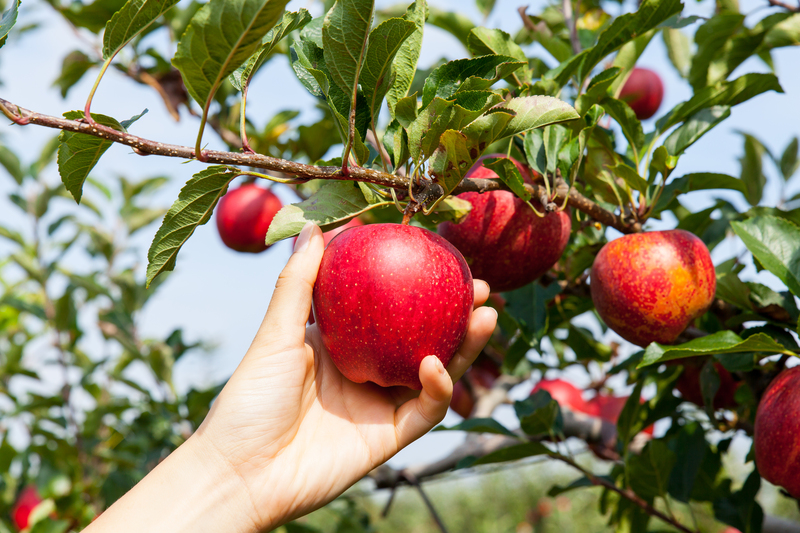Exploring the Role of Gardening in Climate Change Solutions
Posted on 31/08/2025
Exploring the Role of Gardening in Climate Change Solutions
Climate change is an urgent global concern, impacting ecosystems, communities, and the future of life on Earth. As nations worldwide search for effective strategies to combat rising greenhouse gas emissions, gardening emerges as a surprisingly powerful tool in the climate change solutions toolbox.
From carbon sequestration to urban cooling, sustainable food production, and biodiversity enhancement, gardening holds vast potential to make a difference. This comprehensive article delves into how gardening can address climate change, offering actionable insights for individuals, communities, and urban planners. Let's explore the multifaceted role of gardening in building a more sustainable future.

Understanding Gardening and Its Environmental Impact
What is Gardening?
Gardening involves cultivating and caring for plants within a designated space, whether that's a backyard, balcony, rooftop, or community plot. It encompasses a variety of practices including flower gardening, food gardening, permaculture, landscaping, and more. Unlike industrial-scale agriculture, gardening is largely a decentralized, small-scale activity accessible to people across all ages and backgrounds.
The Intersection of Gardening and Climate Change
The connection between gardening and climate change solutions may not be immediately obvious, but when scaled up, even individual gardens collectively reduce environmental impacts. The choices gardeners make - from plant selection to soil care - can either contribute to or help solve the climate crisis.
- Gardening can act as a carbon sink, trapping atmospheric CO2 within plant matter and soil.
- Eco-friendly gardening practices foster ecosystem resilience, vital for adapting to changing climate conditions.
- Home and urban gardens reduce emissions from long food supply chains, packaging, and food waste.
How Gardening Contributes to Climate Change Mitigation
1. Gardening and Carbon Sequestration
Plants play a critical role in capturing atmospheric carbon dioxide. Through the process of photosynthesis, vegetation transforms CO2 into organic matter, storing carbon in roots, stems, leaves, and especially soil. Soil organic carbon is a major carbon pool, and healthy, living soils in gardens act as long-term carbon stores.
- Composting organic waste increases soil fertility and boosts its carbon-holding capacity.
- No-till or low-till gardening minimizes soil disturbance, preserving soil structure and preventing carbon loss.
- Planting perennials and deep-rooted species can sequester carbon more effectively than annual crops.
Collectively, millions of gardens worldwide create a network of microcarbon sinks, offering real, tangible climate action.
2. Urban Gardening and the Heat Island Effect
Urbanization exacerbates climate change through the heat island effect, where cities become significantly warmer than surrounding rural areas due to concrete, asphalt, and lack of green spaces. Urban gardens, green roofs, and vertical gardens are critical solutions in reversing this trend by:
- Providing shade that cools homes, buildings, and streets
- Evaporating water through plant transpiration, reducing ambient air temperature
- Absorbing and reflecting less heat compared to bare concrete or asphalt
Adopting gardening as a climate adaptation strategy can make cities more livable and less energy-intensive.
3. Sustainable Food Production and Reduced Carbon Footprint
The modern industrial food system is a major greenhouse gas emitter. Large-scale farming, fossil fuel-dependent transportation, food processing, and packaging all contribute to emissions. By embracing home, urban, or community gardening, individuals can:
- Reduce dependence on long-haul supply chains
- Grow fresh, seasonal produce with a fraction of the emissions
- Cut down food waste by harvesting only what's needed and composting the rest
Growing your own food is not only eco-friendly, but it also promotes self-sufficiency and resilience during climate-related disruptions.
4. Water Management and Climate Resilience
Climate change increases the occurrence of droughts, floods, and unpredictable weather patterns. Smart gardening practices such as rainwater harvesting, mulching, and drought-tolerant planting enhance a garden's capacity to cope with these challenges. Techniques like swales, rain gardens, and bioswales help capture and filter stormwater, reducing urban flooding while replenishing groundwater.
5. Enhancing Biodiversity and Ecosystem Services
Biodiversity is a critical buffer against the impacts of climate change. Gardens that incorporate native plants, wildflowers, and pollinator-friendly species provide habitat for bees, butterflies, birds, and beneficial insects. Healthy backyard ecosystems contribute several ecosystem services:
- Pollination (essential for food crops and wild plants alike)
- Natural pest control, reducing the need for synthetic chemicals
- Soil building and nutrient cycling
- Local cooling and air purification
By making biodiverse gardens a priority, individuals can support healthy ecosystems that sustain humanity in a changing climate.
Key Climate-Friendly Gardening Practices
1. Composting and Soil Health
Healthy soil is the foundation of a climate-resilient garden. Compost transforms kitchen and yard waste into rich organic matter, fueling beneficial soil microbes and increasing carbon storage. Here's how composting supports climate solutions:
- Reduces methane emissions by diverting organic waste from landfills
- Enriches soil fertility, promoting vigorous plant growth and more CO2 capture
- Improves soil structure and water retention
2. Native and Drought-Resistant Plants
Choosing native and drought-adapted plants minimizes irrigation needs and supports local wildlife. These plants are typically well-suited to regional soil and climate, requiring fewer resources and less maintenance. In a warming world, drought-tolerant gardens are essential for water conservation and climate adaptation.
3. Organic and No-Dig Gardening
Eliminating synthetic fertilizers and pesticides reduces emissions and prevents pollution of waterways. No-dig or minimal dig gardening preserves soil structure and beneficial organisms, maximizing the garden's natural ability to sequester carbon and support biodiversity.
4. Water-Smart Gardening
- Mulching garden beds to reduce evaporation and insulate soil
- Collecting rainwater in barrels to irrigate during dry spells
- Adopting drip irrigation systems for targeted, efficient watering
These techniques ensure water efficiency, a vital component of climate-resilient gardening.
5. Plant Selection for Greater Impact
When designing a garden with climate change mitigation in mind:
- Incorporate fast-growing trees and shrubs with high carbon sequestration rates
- Favor perennial edibles like berries or fruit trees over annuals to maximize carbon storage
- Use cover crops in off-seasons to suppress weeds and enrich the soil
Gardening Success Stories: Global Examples
Urban Gardens in Cities Worldwide
Community gardens in cities like New York, London, and Melbourne demonstrate the power of collective gardening efforts. Rooftop farms in Singapore and Tokyo not only supply residents with fresh produce but also offset city heat and absorb rainwater.
Regenerative Agriculture and Permaculture
Permaculture is a design philosophy that integrates human activity with natural ecosystems for long-term sustainability. Around the globe, regenerative agriculture and permaculture gardens are restoring degraded land and improving carbon sequestration, supporting local food security, and building climate resilience at the grassroots level.
Victory Gardens and Climate Action
Modern "Victory Gardens" recall World War II efforts, when families grew substantial food locally to support wartime rationing. Today's climate-focused victory gardens inspire communities to take meaningful steps in reducing emissions and building climate-smart food systems.
Gardening's Role Beyond the Backyard
Gardening as Climate Education
Gardens are living classrooms where individuals, especially children, can learn about ecosystems, soil health, and food systems. They foster environmental stewardship, equipping future generations with the knowledge and motivation to continue addressing climate challenges.
Policy and Urban Planning for Climate-Smart Gardening
- Cities can create incentives for rooftop and community gardens
- Urban masterplans can mandate green infrastructure in new developments
- Local governments can educate residents about climate-friendly gardening
Supportive policies and urban design are crucial for scaling up gardening's role in climate change mitigation and adaptation.
Challenges and Limitations
While gardening for climate change solutions is impactful, it is not a cure-all. Key challenges include:
- Space constraints in densely populated cities
- Lack of gardening knowledge or resources among some communities
- Extreme weather events that can damage plantings and infrastructure
- Unequal access to green spaces due to socio-economic factors
Overcoming these barriers calls for community engagement, education, and public investment in expanding access to gardening opportunities.

Action Steps: How You Can Help Tackle Climate Change Through Gardening
Get Started or Expand Your Garden
- Start a home or balcony garden, no matter how small
- Join a community gardening group or volunteer on existing initiatives
Adopt Sustainable Gardening Practices
- Compost food scraps and yard waste
- Choose native and climate-adapted plants
- Mulch and use water efficiently
- Limit or eliminate chemical use
Support and Advocate for Climate-Smart Policies
- Advocate for green infrastructure and garden spaces in your community
- Encourage schools and organizations to incorporate gardens into their spaces
Conclusion: Gardening as a Green Solution for a Changing Climate
As the world faces the urgent challenges of global warming, biodiversity loss, and ecosystem degradation, gardening stands out as a practical, cost-effective, and accessible climate change solution. By sequestering carbon, producing local food, cooling urban spaces, conserving water, and nurturing biodiversity, gardens make tangible contributions to a more sustainable planet.
Whether you are a beginner with a few pots on a windowsill or an experienced gardener cultivating diverse green spaces, your efforts matter. Together, through a collective embrace of climate-resilient gardening, we can protect the environment and sow the seeds for a healthier, more sustainable future.
Take up the trowel, plant for the planet, and join the movement that uses gardening as a powerful force in the fight against climate change.

